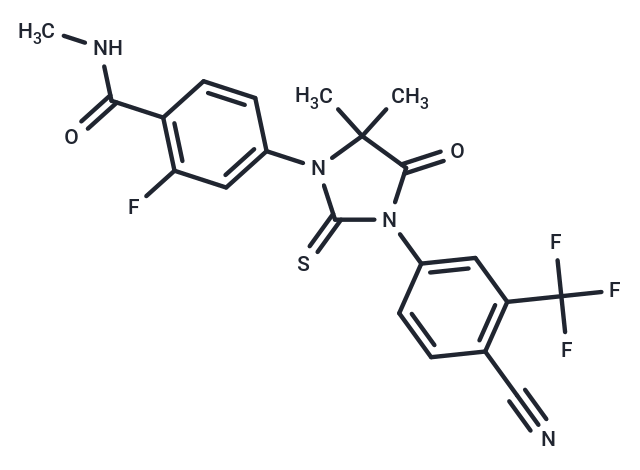Shopping Cart
- Remove All
 Your shopping cart is currently empty
Your shopping cart is currently empty

Enzalutamide (MDV3100) is an androgen receptor (AR) antagonist (IC50=36 nM in LNCaP) that activates autophagy, exhibits antitumor activity, and is commonly used in treating desmoplasia-resistant prostate cancer.

| Pack Size | Price | Availability | Quantity |
|---|---|---|---|
| 5 mg | $40 | In Stock | |
| 10 mg | $51 | In Stock | |
| 25 mg | $68 | In Stock | |
| 50 mg | $97 | In Stock | |
| 100 mg | $156 | In Stock | |
| 200 mg | $197 | In Stock | |
| 500 mg | $288 | In Stock | |
| 1 mL x 10 mM (in DMSO) | $44 | In Stock |
| Description | Enzalutamide (MDV3100) is an androgen receptor (AR) antagonist (IC50=36 nM in LNCaP) that activates autophagy, exhibits antitumor activity, and is commonly used in treating desmoplasia-resistant prostate cancer. |
| Targets&IC50 | Androgen receptor:36 nM (LNCaP cells) |
| In vitro | METHODS: Human prostate cancer cells LNCaP, PC3 and human osteosarcoma cells SJSA-1 were treated with Enzalutamide (0.01-100 μM) for 1 h. Cell viability was measured using MTT. RESULTS: Enzalutamide was shown to decrease the viability of all cell lines, with LD50s of 12 μM, 23.4 μM, and 34.7 μM for LNCaP, PC3, and SJSA-1 cell lines, respectively. [1] METHODS: Human prostate cancer cells VCaP were treated with Enzalutamide (10 μM) for 1-3 days, and the expression levels of target proteins were detected by Western Blot. RESULTS: Enzalutamide up-regulated cleaved-PARP expression and induced apoptosis in human prostate cancer cells. [2] |
| In vivo | METHODS: To assay antitumor activity in vivo, Enzalutamide (1-50 mg/kg) was administered by gavage once daily for twenty-eight days to CB17SCID mice bearing human desmoplastic resistance tumor (CRPC) LNCaP-AR-Lux. RESULTS: Enzalutamide induced regression of tumor volume in a CRPC xenograft model and apoptosis in AR overexpanded prostate cancer cells. [3] METHODS: To assess the role of AR in bone metabolism and bone growth after sexual maturation, Enzalutamide (10-100 mg/kg, 1% carboxymethyl cellulose+0.5% Tween 80+5% dimethylsulfoxide) was administered orally to C57BL/6N mice once daily for twenty-one days. RESULTS: Enzalutamide decreased the amount of bone in the axial skeleton, and Enzalutamide significantly reduced the mechanical strength of the axial skeleton. After sexual maturity, Enzalutamide reduced bone mass in the axial skeleton but not in the appendicular skeleton of male mice. [4] |
| Cell Research | For in vitro experiments, LNCaP or LNCaP/AR cells (10^4 cells/well) were androgen-starved by growth in media containing 5-10% charcoal-stripped serum for 3-5 days. Then the cells were challenged with various concentrations of R1881, bicalutamide, RD162 or MDV3100 in media containing 5-10% charcoal-stripped serum [1]. |
| Animal Research | In vivo tumorigenicity experiments were done by subcutaneous injection of 10^6 cells (100 uL in 50% Matrigel and 50% growth media) into the flanks of castrated male SCID mice. Daily gavage treatment (using a formulation of 1% carboxymethyl cellulose, 0.1% Tween-80, 5% DMSO) was initiated when tumor size reached ~100 mm3. Tumor size was measured weekly in three dimensions (l x w x d) with calipers. For in vivo luciferase imaging, d-luciferin substrate (100 μL, 15 mg/mL) was injected intraperitoneally. After 5 minutes, mice were anesthetized using isofluorane and imaged using a cooled charged-coupled device IVIS camera. Data were analyzed using Living Image 2.30 software [1]. |
| Alias | MDV3100 |
| Molecular Weight | 464.44 |
| Formula | C21H16F4N4O2S |
| Cas No. | 915087-33-1 |
| Smiles | S=C1N(C(C)(C)C(=O)N1C2=CC(C(F)(F)F)=C(C#N)C=C2)C3=CC(F)=C(C(NC)=O)C=C3 |
| Relative Density. | 1.49 g/cm3 |
| Storage | Powder: -20°C for 3 years | In solvent: -80°C for 1 year | Shipping with blue ice. | ||||||||||||||||||||
| Solubility Information | Ethanol: < 1 mg/mL (insoluble or slightly soluble) DMSO: 60 mg/mL (129.19 mM), Sonication is recommended. 10% DMSO+40% PEG300+5% Tween 80+45% Saline: 8.5 mg/mL (18.3 mM), suspension.In vivo: Please add the solvents sequentially, clarifying the solution as much as possible before adding the next one. Dissolve by heating and/or sonication if necessary. Working solution is recommended to be prepared and used immediately. | ||||||||||||||||||||
Solution Preparation Table | |||||||||||||||||||||
DMSO
| |||||||||||||||||||||

Copyright © 2015-2025 TargetMol Chemicals Inc. All Rights Reserved.